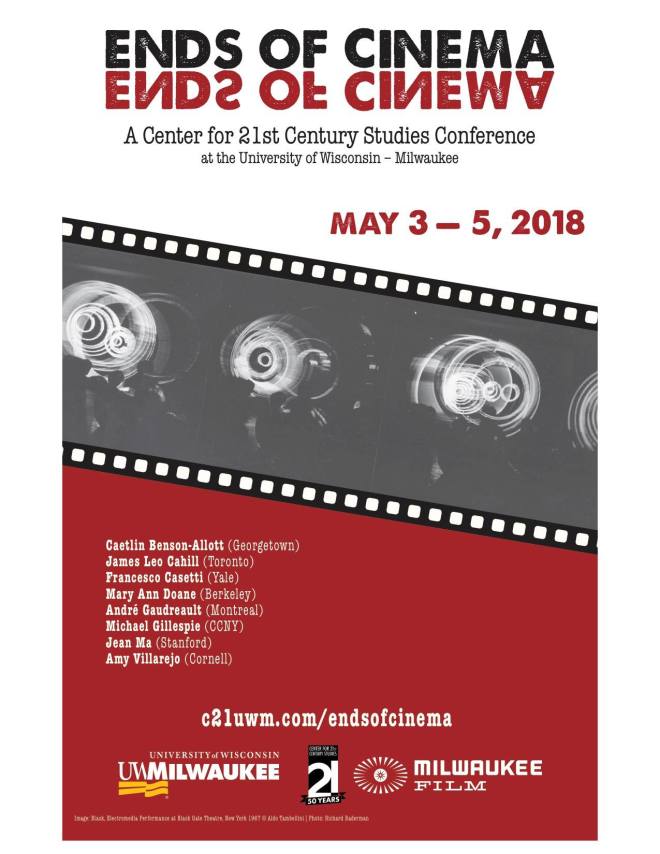
The 2015 Annual C21 Conference (April 30 – May 2, 2015 at the Center for 21st Century Studies, University of Wisconsin-Milwaukee) will be devoted to the theme “After Extinction,” which can be thought from a variety of related perspectives. As the conference CFP put it:
C21’s conference After Extinction will pursue the question of what it means to come “after” extinction in three different but related senses.
1) In temporal terms, what comes after extinction, not only the event of extinction but also the concept? After we think extinction what comes next? Are there historical models or examples of what comes after? Can these past extinctions measure up to present day events, or do the possible scales on which extinction might operate today make such comparisons incompatible? Is extinction something that only happens belatedly, after there are already species or forms or practices in place, or does extinction work prior to the emergence of species, as generative of the evolution or emergence of any form of life or being? Is extinction terminal or can species return, a la Jurassic Park or European projects to restore the auroch or Przewalski’s horse? Can dead or dying languages be revitalized?
2) In an epistemological sense, what does it mean for an image, graphic, text, video or film to “take after” the concept of extinction, to mediate it in such a way as to resemble or be mimetic of extinction. What is “after extinction” in the sense that a painting is “after O’Keeffe” or a child “takes after” its parent? In order to be recognized as coming after extinction an event or occasion must be seen as being related to extinction, to have been consequent or emergent from the event of extinction. Thus we mean to explore the premediation of future extinctions in a variety of formal and informal, print, audiovisual, and networked media. What forms of knowledge emerge in such anticipatory pursuits?
3) In spatial terms, what will remain physically after extinction? Extinction is not simply death or absence but a geophysical event that occurs in space. What does it mean to pursue extinction, to go “after” it with technologies and scientific techniques of making extinction legible by premediating its possible occurrence through climate change modeling or pandemic forecasting? How should one act “after extinction” in order to plan for, prevent, or preempt the end of crucial life forms, for example, by establishing seed banks or stockpiling DNA? How does the extinction of one species threaten the lifeblood of the entire biosphere (e.g., the impact of bee colony collapse on particular flora and fauna as well as on human practices like agriculture)? Have new artifacts surfaced either as sentinels or fossils of extinction (e.g., animal carcasses washed up on shore filled with plastic, or mutant plants in irradiated nuclear test fields)? Even if extinction has always been thought of as impacting a larger ecology, has the scale of risk changed in light of the accelerated networks of the 21st century?
I am very happy to have the opportunity to return to Milwaukee this year in order to pursue these questions at what promises to be another great C21 event! My own paper, which was just accepted, will focus on questions of extinction in relation to the concept of post-cinema.
Here is my abstract:
Post-Cinema after Extinction
Shane Denson
In this presentation, I argue that contemporary, digital moving-image media – what some critics have come to see as properly “post-cinematic” media – are related materially, culturally, and conceptually to extinction as their experiential horizon. Materially and technologically, post-cinema emerges as a set of aesthetic responses to the real or imagined extinction of film qua celluloid or to the death of cinema qua institution of shared reception. Significantly, however, such animating visions of technocultural transformation in the wake of the demise of a formerly dominant media regime are linked in complex ways to another experience of extinction: that of the human. That is, post-cinema is involved centrally in the (pre-)mediation of an experience of the world without us – both thematically, e.g. in films about impending or actual extinction events, and formally, in terms of a general “discorrelation” of moving images from the norms of human embodiment that governed classical cinema. Such discorrelation is evidenced in violations of classical continuity principles, for example, but it is anchored more fundamentally in a disruption of phenomenological relations established by the analogue camera. Digital cameras and algorithmic image-processing technologies confront us with images that are no longer calibrated to our embodied senses, and that therefore must partially elude or remain invisible to the human. Anticipating and intimating the eradication of human perception, post-cinema is therefore “after extinction” even before extinction takes place: it envisions and transmits affective clues about a world without us, a world beyond “correlationism,” that arises at the other end of the Anthropocene – or that we inhabit already.
Bibliography:
Denson, Shane, and Julia Leyda, eds. Post-Cinema: Theorizing 21st-Century Film. Sussex: REFRAME Books, forthcoming.
Kara, Selmin. “Beasts of the Digital Wild: Primordigital Cinema and the Question of Origins.” Sequence 1.4 (2014).
Shaviro, Steven. Post-Cinematic Affect. Winchester: Zero Books, 2009.
Sobchack, Vivian. The Address of the Eye: A Phenomenology of Film Experience. Princeton: Princeton UP, 1992.
_____. “The Scene of the Screen: Envisioning Photographic, Cinematic, and Electronic Presence.” Carnal Thoughts: Embodiment and Moving Image Culture. Berkeley and Los Angeles: U of California P, 2004. 135-162.

